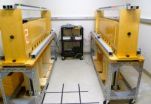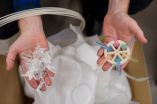(Press-News.org) GAINESVILLE, Fla. — It may seem normal: As we age, we misplace car keys, or can't remember a name we just learned or a meal we just ordered. But University of Florida researchers say memory trouble doesn't have to be inevitable, and they've found a drug therapy that could potentially reverse this type of memory decline.
The drug can't yet be used in humans, but the researchers are pursuing compounds that could someday help the population of aging adults who don't have Alzheimer's or other dementias but still have trouble remembering day-to-day items. Their findings will be published in today's (March 5) issue of the Journal of Neuroscience.
The kind of memory responsible for holding information in the mind for short periods of time is called "working memory." Working memory relies on a balance of chemicals in the brain. The UF study shows this chemical balance tips in older adults, and working memory declines. The reason? It could be because their brains are producing too much of a chemical that slows neural activity.
"Graduate student Cristina Banuelos' work suggests that cells that normally provide the brake on neural activity are in overdrive in the aged prefrontal cortex," said researcher Jennifer Bizon, Ph.D., an associate professor in the department of neuroscience and a member of UF's Evelyn F. & William L. McKnight Brain Institute.
This chemical, an inhibitory brain neurotransmitter called GABA, is essential. Without it, brain cells can become too active, similar to what happens in the brains of people with schizophrenia and epilepsy. A normal level of GABA helps maintain the optimal levels of cell activation, said collaborator Barry Setlow, Ph.D., an associate professor in UF's departments of psychiatry and neuroscience.
Working memory underlies many mental abilities and is sometimes referred to as the brain's mental sketchpad, Bizon said. For example, Bizon said, you use your working memory in many everyday activities such as calculating your final bill at the end of dining at a restaurant. Most people can calculate a 15 percent tip and add it to the cost of their meal without pencil and paper. Central to this process is the ability to keep multiple pieces of information in mind for a short duration — such as remembering the cost of your dinner while calculating the amount needed for the tip.
"Almost all higher cognitive processes depend on this fundamental operation," Bizon said.
To determine the culprit behind working memory decline, the researchers tested the memory of young and aged rats in a "Skinner box." In the Skinner box, rats had to remember the location of a lever for short periods of up to 30 seconds. The scientists found that while both young and old rats could remember the location of the lever for brief periods of time, as those time periods lengthened, old rats had more difficulty remembering the location of the lever than young rats.
But not all older rats did poorly on the memory test, just as not all older adults have memory problems. The study shows the older brains of some people or rats with no memory problems might compensate for the overactive inhibitory system — they are able to produce fewer GABA receptors and therefore bind less of the inhibitory chemical.
Older rats with memory problems had more GABA receptors. The drug the researchers tested blocked GABA receptors, mimicking the lower number of those receptors that some older rats had naturally and restoring working memory in aged rats to the level of younger rats.
"Modern medicine has done a terrific job of keeping us alive for longer, and now we have to keep up and determine how to maximize the quality of life for seniors," Bizon said. "A key aspect of that is going to be developing strategies and therapies that can maintain and improve cognitive health."
INFORMATION: END
UF researchers find drug therapy that could eventually reverse memory decline in seniors
2014-03-05
ELSE PRESS RELEASES FROM THIS DATE:
NASA sees Tropical Cyclone Faxai stretching out
2014-03-05
When a tropical cyclone becomes elongated it is a sign the storm is weakening. Imagery from NASA-NOAA's Suomi NPP satellite today revealed that wind shear was stretching out Tropical Cyclone Faxai and the storm was waning.
On March 5 at 1500 UTC/10 a.m. EST, Tropical Cyclone Faxai's center was located near 22.5 south and 155.2 east, about 699 nautical miles/804.4 miles/ 1,295 km west-northwest of Wake Island. According to the Joint Typhoon Warning Center or JTWC, Faxai's maximum sustained surface winds dropped to 50 knots/57.5 mph/92.6 kph. Faxai was moving to the northeast ...
UCSB study explores cocaine and the pleasure principle
2014-03-05
(Santa Barbara, Calif.) — On the other side of the cocaine high is the cocaine crash, and understanding how one follows the other can provide insight into the physiological effects of drug abuse. For decades, brain research has focused on the pleasurable effects of cocaine largely by studying the dopamine pathway. But this approach has left many questions unanswered.
So the Behavioral Pharmacology Laboratory (BPL) at UC Santa Barbara decided to take a different approach by examining the motivational systems that induce an animal to seek cocaine in the first place. Their ...
First-ever 3D image created of the structure beneath Sierra Negra volcano
2014-03-05
The Galápagos Islands are home to some of the most active volcanoes in the world, with more than 50 eruptions in the last 200 years. Yet until recently, scientists knew far more about the history of finches, tortoises, and iguanas than of the volcanoes on which these unusual fauna had evolved.
Now research out of the University of Rochester is providing a better picture of the subterranean plumbing system that feeds the Galápagos volcanoes, as well as a major difference with another Pacific Island chain—the Hawaiian Islands. The findings have been published in the Journal ...
Brain circuits multitask to detect, discriminate the outside world
2014-03-05
Imagine driving on a dark road. In the distance you see a single light. As the light approaches it splits into two headlights. That's a car, not a motorcycle, your brain tells you.
A new study found that neural circuits in the brain rapidly multitask between detecting and discriminating sensory input, such as headlights in the distance. That's different from how electronic circuits work, where one circuit performs a very specific task. The brain, the study found, is wired in way that allows a single pathway to perform multiple tasks.
"We showed that circuits in the ...
Similarity breeds proximity in memory, NYU researchers find
2014-03-05
Researchers at New York University have identified the nature of brain activity that allows us to bridge time in our memories. Their findings, which appear in the latest issue of the journal Neuron, offer new insights into the temporal nature of how we store our recollections and may offer a pathway for addressing memory-related afflictions.
"Our memories are known to be 'altered' versions of reality, and how time is altered has not been well understood," said Lila Davachi, an associate professor in NYU's Department of Psychology and Center for Neural Science and the ...
Are bilingual kids more open-minded?
2014-03-05
This news release is available in French. Montreal, March 5, 2014 — There are clear benefits to raising a bilingual child. But could there be some things learning a second language doesn't produce, such as a more open-minded youngster?
New research from Concordia University shows that, like monolingual children, bilingual children prefer to interact with those who speak their mother tongue with a native accent rather than with peers with a foreign accent.
The study, published in the journal Frontiers in Psychology and co-authored by psychology professors Krista ...
Save money and the planet: Turn your old milk jugs into 3D printer filament
2014-03-05
Making your own stuff with a 3D printer is vastly cheaper than what you'd pay for manufactured goods, even factoring in the cost of buying the plastic filament.
Yet, you can drive the cost down even more by making your own filament from old milk jugs. And, while you are patting yourself on the back for saving 99 cents on the dollar, there's a bonus: you can feel warm and fuzzy about preserving the environment.
A study led by Joshua Pearce of Michigan Technological University has shown that making your own plastic 3D printer filament from milk jugs uses less energy—often ...
Seeking quantum-ness: D-Wave chip passes rigorous tests
2014-03-05
With cutting-edge technology, sometimes the first step scientists face is just making sure it actually works as intended.
The USC Viterbi School of Engineering is home to the USC-Lockheed Martin Quantum Computing Center (QCC), a super-cooled, magnetically shielded facility specially built to house the first commercially available quantum computing processors – devices so advanced that there are only two in use outside the Canadian lab where they were built: The first one went to USC and Lockheed Martin, and the second to NASA and Google.
Since USC's facility opened ...
Calcium and vitamin D improve cholesterol in postmenopausal women
2014-03-05
CLEVELAND, Ohio (March 5, 2014)—Calcium and vitamin D supplements after menopause can improve women's cholesterol profiles. And much of that effect is tied to raising vitamin D levels, finds a new study from the Women's Health Initiative (WHI) just published online in Menopause, the journal of The North American Menopause Society (NAMS).
Whether calcium or vitamin D can indeed improve cholesterol levels has been debated. And studies of women taking the combination could not separate the effects of calcium from those of vitamin D on cholesterol. But this study, led by NAMS ...
Blocking immune system protein in mice prevents fetal brain injury, but not preterm birth
2014-03-05
An inflammatory protein that triggers a pregnant mouse's immune response to an infection or other disease appears to cause brain injury in her fetus, but not the premature birth that was long believed to be linked with such neurologic damage in both rodents and humans, new Johns Hopkins-led research suggests.
The researchers, reporting online March 5 in the American Journal of Reproductive Immunology, also say they found that an anti-inflammatory drug that is FDA-approved for rheumatoid arthritis and is believed to be safe for humans to take during pregnancy halted the ...



